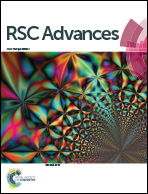New carvacrol and thymol derivatives as potential insecticides: synthesis, biological activity, computational studies and nanoencapsulation†
Abstract
New compounds with potential insecticide activity were synthesized by structural modifications performed in the monoterpenoid phenolic moieties of carvacrol and thymol, resulting in a set of derivatives with the ether function containing the propyl, chloropropyl or hydroxypropyl chains, as well as a bicyclic ether with an unsaturated chain containing a carboxylic acid terminal. In addition, an analogue of carvacrol and thymol isomers bearing methoxyl, 1-hydroxyethyl and (3-chlorobenzoyl)oxy, instead of the three original methyl groups, was also synthesized. Several structural changes that resulted in diminished insecticide activity have been identified, but two significantly active molecules have been synthesized, one of them being less toxic to human cells than the naturally-derived starting materials. Structure-based inverted virtual screening and molecular dynamics simulations demonstrate that these active molecules likely target the insect odorant binding proteins and/or acetylcholinesterase and are able to form stable complexes. For the most promising compounds, nanoencapsulation assays were carried out in liposomes of egg phosphatidylcholine/cholesterol (7 : 3) prepared by both thin film hydration and ethanolic injection methods. The compound-loaded liposomes were generally monodisperse and with sizes smaller than or around 200 nm. The thin film hydration method allowed high encapsulation efficiencies (above 85%) for both compounds and a delayed release, while for the systems prepared by ethanolic injection the encapsulation efficiency is lower than 50%, but the release is almost complete in two days.



 Please wait while we load your content...
Please wait while we load your content...